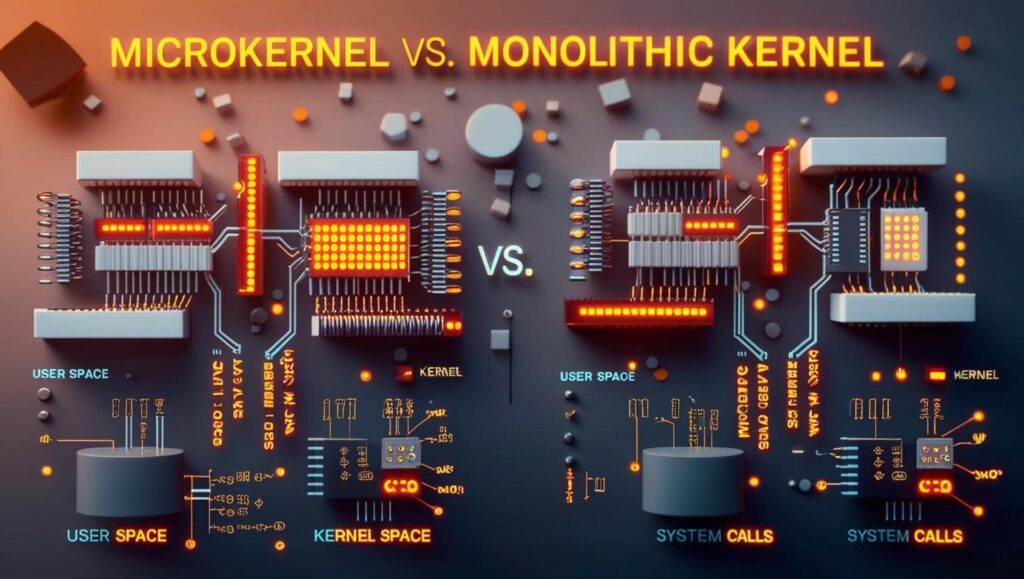
In the evolving landscape of operating systems and cloud computing, understanding the foundational architectures is crucial. Two primary kernel architectures—monolithic and microkernel—serve as the backbone for various operating systems. Additionally, the rise of containers has revolutionized application deployment and scalability. This article delves into these concepts, exploring their differences, applications, and implications in modern computing environments.
Understanding Kernel Architectures
Monolithic Kernel
A monolithic kernel is a single large process running entirely in a single address space. It includes not only the core functionalities like memory management and process scheduling but also device drivers, file system management, and system server calls. This design allows for efficient system call execution but can lead to stability issues, as a fault in any part of the kernel can crash the entire system.
Microkernel
In contrast, a microkernel provides only the minimal necessary functionalities, such as low-level address space management, thread management, and inter-process communication (IPC). Other services like device drivers, file systems, and network protocols run in user space. This separation enhances system stability and security, as faults in user space services do not compromise the entire system.
Microkernel Architecture
Core Components
The microkernel architecture focuses on minimalism and modularity. Its core components typically include:
-
Inter-Process Communication (IPC): Facilitates communication between various services and applications.
-
Basic Scheduling: Manages the execution of processes.
-
Low-Level Memory Management: Handles memory allocation and protection mechanisms.
By delegating other services to user space, the microkernel ensures that the core remains small and less prone to bugs.
Advantages and Disadvantages
Advantages:
-
Modularity: Easier to maintain and update individual components.
-
Stability: Faults in user space services do not crash the entire system.
-
Security: Reduced attack surface due to minimal kernel code.
Disadvantages:
-
Performance Overhead: IPC between user space services can introduce latency.
-
Complexity: Designing efficient communication between numerous modules can be challenging.
Containers in Operating Systems
Definition and Purpose
Containers are lightweight, standalone, and executable software packages that include everything needed to run an application: code, runtime, system tools, libraries, and settings. They share the host system’s kernel but operate in isolated user spaces, ensuring consistency across multiple environments.
Microkernel and Containers
Microkernels and containers share the philosophy of modularity and isolation. In microkernel-based systems, services run in user space, similar to how containers encapsulate applications. This alignment allows for enhanced security and stability, as each container or service operates independently, reducing the risk of system-wide failures.
Microkernel vs. Monolithic Kernel

| Feature | Monolithic Kernel | Microkernel |
|---|---|---|
| Structure | Single large process | Minimal core with user space services |
| Stability | Less stable; faults can crash the system | More stable; faults isolated to user space |
| Performance | Generally faster due to fewer context switches | Potentially slower due to IPC overhead |
| Modularity | Low; tightly integrated components | High; modular and easily maintainable |
| Security | Larger attack surface | Smaller attack surface |
Microkernel Operating Systems in Practice
FreeBSD Jails
FreeBSD Jails provide a lightweight virtualization mechanism, allowing administrators to partition a FreeBSD system into several independent mini-systems called jails. Each jail has its own filesystem, users, and network interfaces, enhancing security and resource management.
Solaris Zones
Solaris Zones, also known as Solaris Containers, offer a similar approach by enabling multiple secure and isolated environments within a single Solaris OS instance. Each zone acts as a separate virtual server, sharing the same kernel but operating independently.
Linux Containers (LXC)
Linux Containers (LXC) utilize kernel features like namespaces and control groups to provide process and resource isolation without the overhead of full virtualization. LXC allows multiple isolated Linux systems (containers) to run on a single host.
Conclusion
Understanding the distinctions between microkernel and monolithic kernel architectures is vital for system design and application deployment. Microkernels offer modularity and stability, while monolithic kernels provide performance advantages. The integration of containers has further transformed the computing landscape, promoting scalability and consistency. Leveraging cloud services like AWS Free Tier enables users to experiment and build applications efficiently, provided they monitor usage and understand the associated limits.
Frequently Asked Questions (FAQs)
1. What is the primary difference between a microkernel and a monolithic kernel?
A microkernel includes only essential services in the kernel space, delegating others to user space, enhancing stability and security. In contrast, a monolithic kernel incorporates all services into a single large process, offering performance benefits but potentially compromising stability.
2. How do containers relate to microkernel architecture?
Both containers and microkernels emphasize modularity and isolation. While microkernels separate services into user space processes, containers encapsulate applications and their dependencies, ensuring consistent and isolated environments.
3. What are some examples of microkernel-based operating systems?
Examples include FreeBSD with its Jails feature, Solaris with Zones, and Linux utilizing LXC for containerization. These systems implement microkernel principles to varying degrees.
